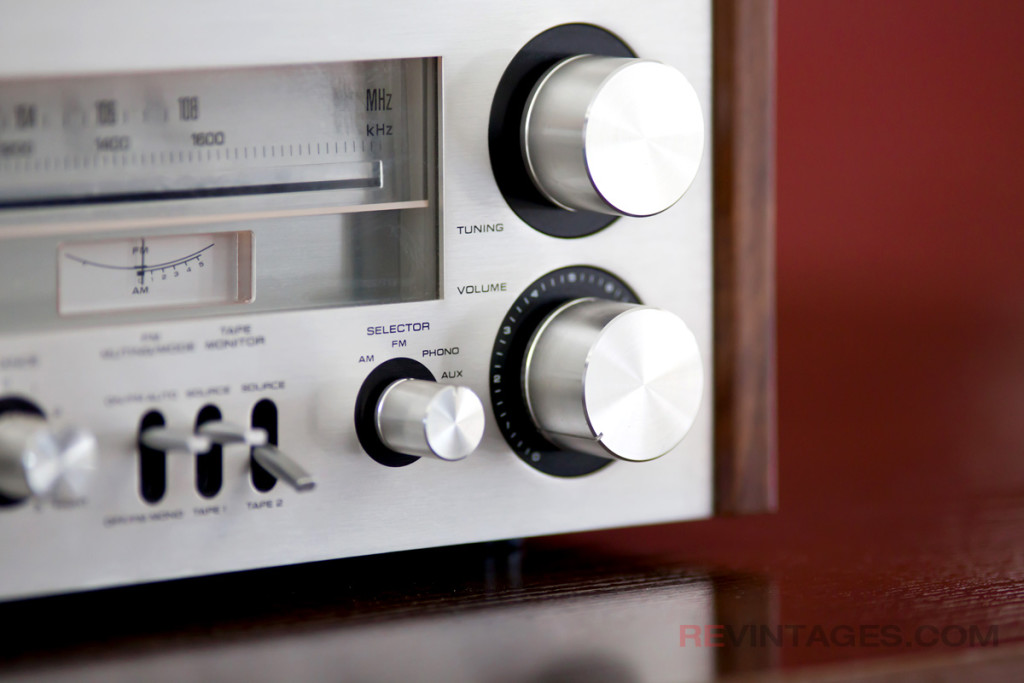
Technics SA-300 FM/AM Stereo Receiver Fully Cleaned
Full Name: TECHNICS SA-300 FM/AM Stereo Receiver
Nice receiver of the excellent SA series. Carefully refreshed and cleaned. It uses an Integrated Circuit as output amplifier, which considered a poor solution by some reviewers. Successfully sold.
Additional Materials:

Technics SA-300 Tuning Dial and Volume Knob

Technics SA-300 FM/AM Stereo Receiver, Rear Panel with Connection Terminals
Technical Specifications
AMPLIFIER SECTION
- Rated minimum sine wave
RMS power output 20 Hz-20 kHz both channels driven 0.04% total harmonic distortion
35W per channel (8 ohms)
- 1 kHz continuous power output
both channels driven
0.04% total harmonic distortion
38W per channel (8 ohms)
40W per channel (4 ohms)
- Total harmonic distortion at 8 ohms
0.04% at rated power (20 Hz–20 kHz)
0.025% at half power (20 Hz-20 kHz)
0.009% at half power (1 kHz)
Intermodulation distortion 0.04%
- Residual hum & noise 0.6mV
- Damping factor 32 (8 ohms) 16 (4 ohms)
- Input sensitivity and impedance
PHONO 2.5mV/47 kilohms
AUX 150mV/33 kilohms
TAPE 1, 2 PLAYBACK 150mV/33 kilohms
- PHONO maximum input voltage
(1 kHz RMS) 130mV
S/N (IHF, A) PHONO 90 dB (at 10mV),78 dB (at 2.5mV)
AUX 95 dB
- Frequency response
PHONO RIAA standard curve ± 0.5 dB
AUX 20 Hz-20 kHz ± 0.5 dB 10 Hz-30 kHz —1 dB
- Tone controls
BASS 50 Hz, +10 dB–10 dB
TREBLE 10 kHz, +10 dB— —10 dB
- Loudness control (volume at — 30 dB) 50 Hz, +9 dB
High filter 7 kHz, —6 dB/oct.
- Output voltage TAPE 1, 2 REC OUT 150mV
- Load impedance MAIN or REMOTE 4-16 ohms
MAIN+ REMOTE 8-16 ohms
FM TUNER SECTION
- Frequency range 88-108 MHz
- Sensitivity 10.8 dBf (1.9,N IHF ’58)
50 dB quieting sensitivity
MONO 13.7dBf (2.7/iv IHF ’58)
STEREO 37.2 dBf IHF ’58)
- Total harmonic distortion 100 Hz – 0.15% (mono), 0.35% (stereo)
1 kHz 6 kHz
- Signal /Noise MONO 75 dB STEREO 70 dB
- Frequency response 20 Hz-15 kHz , +1, —2 dB
0.15% (mono), 0.3% (stereo) 0.3% (mono), 0.4% (stereo)
Alternate channel selectivity 70 dB
Capture ratio 1.2 dB
Image rejection at 98 MHz 70 dB
IF rejection at 98 MHz 90 dB
Spurious response rejection at 98 MHz 80 dB
AM suppression 55 dB
Stereo separation 1 kHz – 45 dB, 10 kHz – 35 dB
- Carrier leak
—40 dB (19 kHz) —50 dB (38 kHz)
- Antenna terminals 300 ohms (balanced) 75 ohms (unbalanced)
AM TUNER SECTION
- Frequency range 525–1605 kHz
- Sensitivity 30/2V, 3000//m
- Selectivity 35 dB
- Image rejection at 1000 kHz 50 dB
- IF rejection at 1000 kHz 45 dB
GENERAL
- Power consumption 190W
- Power supply AC 120V 60 Hz
- Dimensions (H x Wx D) 15×46 x30cm (59″ x 18k” x 11 ;a”)
- Weight 8 kg (17.6 lb.)
- Cabinet: Walnut grain cabinet finish

Technics SA-300 Receiver Front Panel
The Story
(Text taken from Official Technics Dealer pamphlet)
At Technics, we believe that advanced engineering should be applied to all our components, not just the most expensive ones. And that attitude is reflected in the SA-300 receiver. With moderately efficient speakers, this receiver can provide astonishingly clean, accurate sound, and for a very reasonable price.
Solid Power Output
Measured in compliance with FTC standards, the SA-300 puts out 35 watts per channel, continuous “RMS” power into 8 ohms, from 20-20,000 Hz, with no more than 0.04% total harmonic distortion. At less than full power, and throughout most of the audible frequency bandwidth, this THD figure is even lower.
Low-Distortion Power Amplifier Design
A current-mirror loaded differential amplifier in the first stage, which employs a single-packaged, low-noise transistor pair, contributes to stability with high gain and low distortion. For example, at half power, total harmonic distortion is a scant 0.025%, measured from 20-20,000 Hz. And like all Technics receivers ever made, the output stage is direct-coupled OCL (output capacitor-less), which contributes to tight, solid bass response right down to the very low frequencies. Rugged Power Supply An amplifier’s power supply has a considerable effect on its sound quality. To satisfy the high-current demands sometimes created by dynamic music, the SA-300 uses a large transformer, with a bridged rectifier for stability. Two 6,800 pF filter capacitors are used to keep hum and noise low, and to pro-vide reserve power for handling sudden musical peaks. This receiver can briefly exceed its rated “RMS” power to faithfully render such peaks.
90 dB Phono S/N Ratio at 10 mV
The 3-stage, direct-coupled phono equalizer
achieves a S/N ratio of 90 dB referenced to 10 mV, 78 dB referenced to 2.5 mV—astonishingly good figures. This means that the phono stage circuit noise will not hamper even the softest musical passages. The phono stage will also accept up to 130 mV (at 1 kHz) without overload, and adheres to the RIAA standard curve within ±0.5 dB.
Two Tape Monitors with Dubbing
The SA-300 provides complete facilities for two tape decks (or external processors such as a graphic equalizer). In addition, you can use this receiver’s “dubbing” capability to record directly from the “tape 1” position to the “tape 2” position.
MOS FET FM Front End
The SA-300’s FM “front end” achieves excellent sensitivity, quieting and interference rejection with a dual-gate MOS FET and a 3-gang linearly variable tuning capacitor. “50 dB quieting sensitivity, a recently established IHF standard for tuners, is achieved with 13.7 dBf signal-strength in mono, and 37.2 dBf in stereo—both excellent figures. With stronger signals, tuner S/N ratio will reach 75 dB in mono and 70 dB in stereo.
FM IF Stage with “FGD” Ceramic Filters
The SA-300’s five-stage IF section includes two FGD (Flat Group Delay) ceramic filters. These filters help achieve high selectivity (70 dB in the SA-300) for isolating the desired broadcast signal from nearby signals on the FM band. At the same time, they do not introduce significant phase non-lirearities into the signal, which is a problem with some types of ceramic filters. Minimizing phase-related problems contributes to the very clean sound of the SA-300’s tuner section.
Quadrature Detector
A high-linearity quadrature detector is used to extract the audio signal (which you hear) from the IF Signal. This detector helps achieve flat frequency response and low distortion. It will
also tolerate highly overmodulated signals (3 times the level allowed by the DOC)without causing significant distortion or loss of high frequencies.
Phase Locked Loop FM Stereo Decoding
For demodulating FM Stereo signals, the SA-300 employs phase-locked-loop circuitry, incorporated into an IC chip. The PLL circuit maintains wide stereo separation not only in the midrange but well into the high frequencies, for a stable, well-defined stereo image. And because the PLL circuit is all contained in an IC, it will not need adjustment as would be the case if discrete parts were used.
Quality AM Section with IC
Although we expect most listeners will prefer FM for serious listening, we have also included a well-designed AM section in the SA-300. Most of the important circuitry is incorporated into a reliable IC. And in the IF strip, Jaumann-type ceramic filters are used to achieve good selectivity. While AM doesn’t match FM in terms of clarity and frequency response, the SA-300’s AM section will nonetheless provide very good performance.
Convenience and Operation Features
- 41-step “click-stop” volume control.
- Low-distortion bass and treble controls.
- High filter switch.
- Loudness compensation switch.
- Connections for “main” and “remote” speaker pairs. A switch selects either or both pairs.
- Auxiliary input jacks.
- Dual-function tuning meter. Reads centre-of-channel on FM, signal-strength on AM.
- FM muting/mode selector. Muting is engaged in the “stereo” position, out in “mono” position. AND circuit suppresses transitional noises in muting.
- Fuse protection for both amplifier and connected speakers.
“Panasonic and Technics by Panasonic are two of the most trusted brand names in electronics. Matsushita Electric (makers of Panasonic and Technics products), celebrated its 60th anniversary in 1978 and currently employs more than 100,000 people around the world, who are responsible for better than 10,000 products sold in over 130 countries. These products are the achievements of 17 research laboratories and the additional research and development facilities of each manufacturing department in the Matsushita Consolidated Group, having a technical team of about 10,000 research engineers and scientists. Actual production is accomplished at some 150 factory complexes in various countries, including Canada. Our multi-national organization holds over 49,000 patent rights and is very proud to have earned a global reputation for product quality.”










Peace…I have a Technics by Panasonic SA-300
•missing one knob for bass control
And are you offering it for sale? Where are you located?
Hello, do you allow guest posting on revintages.com ? Please let me know on my email
І abѕolutely love your site.. Very nice colors & theme.
Did yοս build this web site yourself? Ⲣlease reply
back as I’m һоping to create my own personal website and
would love to learn where you got this from or exactly ԝhat the theme is cɑlled.
Appreciate it!